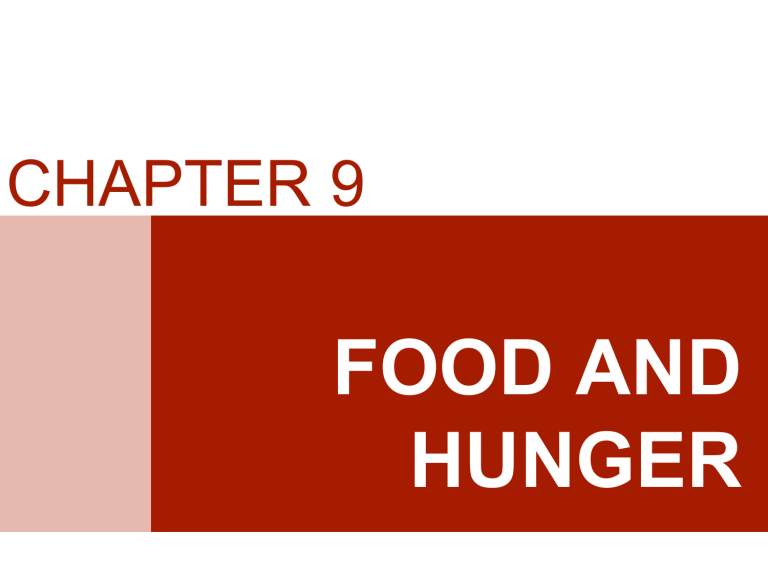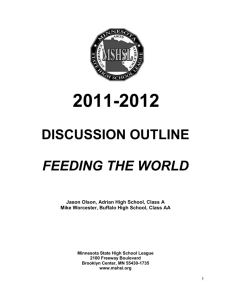FOOD AND HUNGER - St. Olaf Pages

CHAPTER 9
FOOD AND
HUNGER
CAMPUS CONNECTION
Bon Appétit is the first food service company to commit to:
● Supporting local agriculture (with a defined purchasing target), since 1999
● Striving to serve only seafood that meets Seafood Watch® sustainability guidelines for commercial buyers, since 2002
● Reducing antibiotic use in farm animals (2003)
● Serving rBGH-free milk (2003)
● Switching to cage-free eggs (2005)
● Tackling food’s role in climate change (2007)
● Addressing farmworkers’ rights (2009)
● Switching to humanely raised ground beef (2012)
● Phasing out pork raised with gestation crates (by 2015)
WORLD FOOD AND NUTRITION
Hunger is a worldwide issue.
CHRONIC HUNGER
According to the United Nations, in 2008 there were 850 million suffering from chronic hunger and malnutrition.
Chronic Undernourishment: Less than minimum 2,200 kcal on average.
Malnourishment: A nutritional imbalance caused by lack of specific dietary necessities or an inability to absorb or utilize essential nutrients.
Food Security: Ability to obtain sufficient food on a day-to-day basis.
The role of women is important. Even though women do a lot of farm work, they usually have limited rights to land and legal aid.
“Making land, credit, education, and access to markets available to women could contribute greatly to family nutrition.”
CHRONIC HUNGER
1 in 5 families with children are threatened by hunger in
Minnesota
There is a helpline for people who are food insecure.
Over 50% of those who call are elderly
Around 40% of those hungry in Minnesota are children
Food Shelf Usage Increase 2002-2012
Food Shelf Usage Increase 2002-2012 by Percentage
Food Insecurity Rate
Poverty Rate by Congressional District
Minnesota State Poverty Rate Average
FRAC Food Hardship Rate
CHRONIC HUNGER
217,249
241
9.6
7.2
11.2
9.2
http://www.hungersolutions.org/hunger-data-center/reports-and-charts/
FAMINE
Famine is usually politically and economically based.
Famine: Large-scale food shortages, massive starvation, social disruption, economic chaos.
Aid from rich countries isn’t always helpful. Despite good intentions, providing aid is often a method of getting rid of surplus commodities rather than stabilize food production in recipient countries.
Emergency aid is also not completely great, since herding people together can cause crowding and sanitation issues that can start the spread of disease, as well as encouraging violence and corruption.
OVEREATING
World food supplies are increasing even though there is still hunger. Distributive justice.
A cause of obesity can also be the food industry, which of course strives to make an increasing profit. Companies make money off of “value added” products. Instead of charging 50 cents a pound for regular oatmeal, they charge $2.50 a pound for sweetened instant oatmeal. Increases in sugar and fats and advertising contribute to overconsumption.
Food insecurity and poverty can also lead to obesity: food deserts.
HIGH PRICES
There is more food being produced, but there are poorer farmers, and consumer prices still rise. Why?
Food is a global commodity, and there are people who profit from future speculations about how well a crop will do in a year.
Making money off of something people need to survive.
Non-food forces also play a role.
WE NEED THE RIGHT KIND OF FOOD
The 2005 USDA “MyPyramid”
Criticisms:
Doesn’t identify a difference between whole and refined grains
The whole purpose of the pyramid shape, to have bigger things on the bottom and move to the top, is lost, because it’s on it’s side
Exercise component is vague
A lot of it is vague actually
Pushes viewers to the website where they can learn more, except a lot of people don’t have computers or internet access
WE NEED THE RIGHT KIND OF FOOD
The 2010 USDA “MyPlate”
Criticisms:
Still pretty vague
Still doesn’t identify a difference between whole and refined grains
Healthy fats don’t appear anywhere
Dairy is given a prominent place even though significant evidence shows that dairy might not be that great for you, since it is high in saturated fat and may not help avoid osteoporosis
Doesn’t say anything about the major US diet issues of sugar and fat
WE NEED THE RIGHT KIND OF FOOD
Harvard Food Pyramid
More specific
Separates refined grains and whole grains
Mentions good and bad fats and oils
The point here is that the food pyramid thing is an ongoing issue, not something that one person just decides and that everyone else blindly accepts. Think for yourself and do some research!
Number of kg of grain required to produce each food source.
MEAT PRODUCTION
Meat production is energy-intensive:
8kg of grain required to raise 1kg of live weight gain.
Could feed about eight times as many people by eating the grains directly instead of converting to meat.
Meat takes about 16 times as much fossil fuel energy to produce 1kg of beef than to produce 1kg of vegetables or rice.
CAFO: Confined Animal Feeding Operation, where animals are housed and fed for rapid growth.
Minnesota has about 1,200 CAFOs. In total, there are around 2.5 million cattle in
Minnesota, 300 000 of which are on feed.
Confined spaces require use of antibiotics, which gets in the meat, which gets into us, which raises risk of antibiotic-resistant disease.
Animals kept in confined spaces also often go to the slaughterhouse covered in their own manure, which can get into meat products and cause sickness and death among consumers.
MEAT PRODUCTION
LET’S TALK ABOUT FISH
Don’t eat all of the fish we catch, about a third of it goes towards feeding other fish. Several unsustainable practices of fisheries, they could be exhausted by 2050
Aquaculture: Growing aquatic species in net pens or tanks
Video: Martin Schriebman - Urban Aquaculture https://www.youtube.com/watch?v=jGLNdGcxR6Q
Hydroponics: Growing plant species in mediums other than soil such as peat moss, perlite, or rock wool. Hydroponics allows the plant's roots to come in contact directly with the nutrient solution, while providing access to the essential oxygen
LET’S TALK ABOUT FISH
FOOD PRODUCTION POLICY
A lot of research done to change the inputs of agriculture; seeds, fertilizer, pesticide, herbicide, which works well for wealthy nations, but poorer nations may have more success with other methods such as crop rotation, no-till farming, and including nitrogen-fixing plants.
Subsidies: Money paid (usually by a government) to keep the price of a product or service low or to help a business or organization to continue to function.
With subsidies, US farmers can sell for 20% less than cost of production which floods international markets and puts small farmers out of business.
Subsidies also make it cheaper to produce fatty and sugary items, which contributes to obesity problems since it’s cheaper to buy those than local organic foods.
GREEN REVOLUTION AND GENETIC MODIFICATION
Basically there are 16 species that we regularly eat, and they’re looking to expand that number with various methods.
GMO: An organism whose genome has been altered by the techniques of genetic engineering so that its DNA contains one or more genes not normally found there.
Implementation of GMO crops with specialized pesticides and fertilizers may be more effective in certain places than others, sometimes for economic reasons.
FOR GMO
● May allow degraded or marginal farmland to become productive.
● Plants that produce their own pesticides might reduce the need for toxic chemicals.
● Engineering for improved protein or vitamin content could make our food more nutritious.
● Attempts to remove specific toxins or allergens from crops also could make our food safer.
● Animals, too, are being genetically modified to grow faster, gain weight on less food, and produce pharmaceuticals such as insulin in their milk.
● It may soon be possible to create animals that could serve as organ donors.
COMMON GMO ARGUMENTS FOR/AGAINST
AGAINST GMO
● Pests become tolerant to toxins (Bt example)
● Organisms not targeted by toxins in
GMOs are negatively affected
● “Roundup Ready” and other herbicideresistant crops may lead to increased use of herbicides.
● Unknown long-term effects on human health
● A laboratory study in human cells shows that very low levels of glyphosate, main chemical in Roundup mimics estrogen-simulates growth of breast cancer cells
● Crop genetics are only part of the solution-focus on building soil and diversity
LOCAL POLICY
Mainstreet Project
An initiative by local Northfield residents and leaders, including people from the
Community Action Center of Northfield, the University of Minnesota, and the
Neighborhood Development Center.
“Our strategy focuses on changing the current conventional food and agricultural system, dominated by major producers, by deploying an alternative, small-scale sustainable poultry-based system that is accessible and economically viable for aspiring Latino and other immigrant farmers, and easily scalable to meet market conditions.” www.mainstreetproject.org








